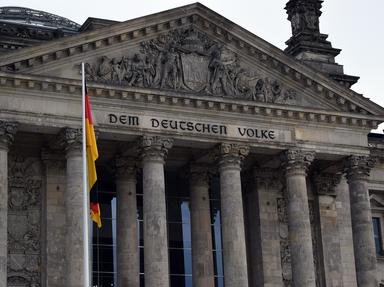Quiz Answer Key and Fun Facts
1. After the Reichstag fire Hitler persuade President Hindenburg to issue a decree that gave the government emergency powers until the Communist danger had passed. This decree allowed the government which of these powers?
2. When Hitler was named chancellor a deal was struck which only allowed for three other Nazi Party members in the cabinet. This, Hindenburg thought, would prevent Hitler and the Nazis from controlling the government. One of the cabinet posts was that of Minister without Portfolio. The man also became Minister of the Interior and head of the police in Prussia. Who was it?
3. In developing his mass political movement, Adolf Hitler used ritualistic ceremonies as a means of binding party members to his own person. One of the rituals involved the use of the "blood flag". What was this flag?
4. On 7 June 1933 Britain, France, Germany, and Italy agreed to terms of the Four-Power Pact. What was the stated objective of this pact?
5. Between 20 May 1928 and 6 November 1932 four general elections were held to elect Deputies to the Reichstag. Of all the parties which one gained seats consitently from election to elections?
6. As we have seen, the Nazi party received 37.8 % of the vote in the 31 July 1932 general elections making the Nazis the largest represented party in the Reichstag by far yet no Nazi was represented in the government cabinet. Why was this?
7. Hitler was offered the vice-chancellorhsip but refused! Now what was the problem?
8. Germany had been without a Chancellor since September 12 so Hitler once again tested Hindenburg's resolve when, on November 23, he again sought to be appointed chancellor with additional presidential powers but the old war horse would not cave in to Hitler's demand and refused to appoint Hitler Chancellor. Whom did Hindenburg appoint as Chancellor?
9. It will be reasonable to assume that the Weimar Republic government had been in crisis for years but some still held out hopes that its political structure would remain intact. The crisis came to a head when Hitler became Chancellor. Which event most directly influenced the end of the Weimar Republic?
10. From 29 June-1 July 1934 Hitler ordered a series of murders to purge the SA leadership. Called "the night of the long knives" or "the blood purge" these murders also eliminated important individuals not associated with the SA but considered by Hitler to be a danger to the régime. From the list who was NOT a victim of the "blood purge"?
Source: Author
HTG
This quiz was reviewed by FunTrivia editor
bloomsby before going online.
Any errors found in FunTrivia content are routinely corrected through our feedback system.

